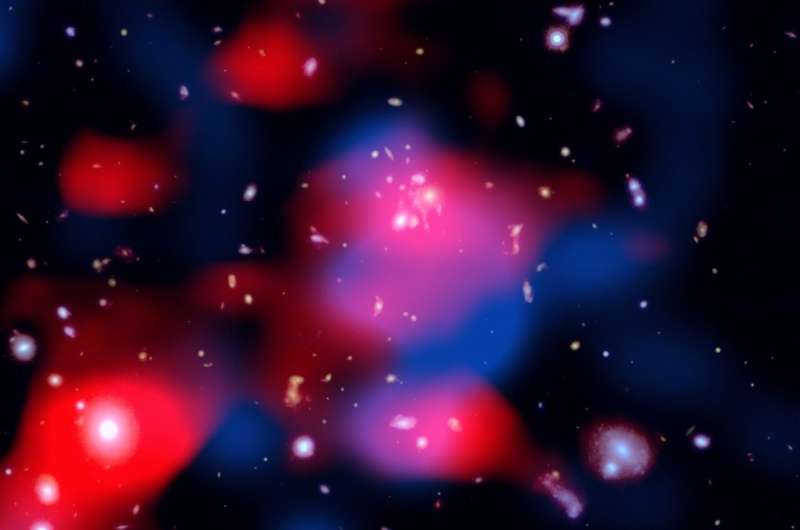Table of Contents

An Ancient Signal, 10 Billion Years in the Making
Astronomers have discovered a mini halo in the early universe—a vast, faint cloud of high-energy particles surrounding a distant galaxy cluster, some 10 billion light-years from Earth. This marks the most remote mini halo ever observed, twice as far as any previously known. The finding not only opens a new window into the young universe but also shifts how scientists understand the energetic environments surrounding galaxy clusters.
The discovery, published in The Astrophysical Journal Letters, centers on a galaxy cluster named SpARCS1049, where researchers detected a large-scale radio signal coming not from individual galaxies, but from a glowing, diffuse region of space. This region—over a million light-years across—revealed the presence of a mini halo in the early universe, made up of energetic particles and magnetic fields swirling in the cosmic void between galaxies.
What Is a Mini Halo, and Why Does It Matter?
A mini halo is a cloud of highly energetic, charged particles that emit radio waves. These halos don’t originate from a single source like a galaxy or a star, but from the intergalactic space within a galaxy cluster. Detecting a mini halo in the early universe is significant because it shows that these powerful energy processes were already at work shortly after galaxy clusters began to form.
Julie Hlavacek-Larrondo of Université de Montréal, co-leader of the research team, explained:
“It’s as if we’ve discovered a vast cosmic ocean, where entire galaxy clusters are constantly immersed in high-energy particles.”
This discovery implies that the colossal structures of the universe—galaxy clusters—were already being shaped by dynamic, high-energy environments billions of years earlier than previously thought.
How Was the Mini Halo Discovered?
The team used data from LOFAR (Low Frequency Array), a giant radio telescope network with over 100,000 antennas spread across eight European countries. LOFAR is uniquely suited to detect the faint radio signals emitted by mini halos.
While examining the SpARCS1049 cluster, researchers noticed a diffuse radio glow. Its size and shape ruled out traditional sources like galaxies or black holes. What they had found was a mini halo in the early universe, its radio signature still reaching Earth after a 10-billion-year journey through space.
Roland Timmerman of Durham University, the study’s co-leader, noted:
“It’s astonishing to find such a strong radio signal at this distance. It means these energetic particles and the processes creating them have been shaping galaxy clusters for nearly the entire history of the universe.”
Two Possible Origins of the Mini Halo
Understanding what creates a mini halo in the early universe involves complex astrophysics, but the researchers have narrowed it down to two main possibilities:
1. Supermassive Black Holes
Some galaxies within clusters host massive black holes at their centers. These black holes can eject streams of high-energy particles during periods of intense activity. These jets might travel great distances and fill surrounding space with charged particles and magnetic fields. However, it’s still unclear how these particles retain enough energy over such vast scales to form a glowing mini halo.
2. Cosmic Particle Collisions
Another possibility is that the mini halo forms from high-speed collisions between particles in the hot plasma of the cluster. These near-light-speed collisions could produce showers of secondary particles that give off radio waves. If this is the case, then galaxy clusters themselves are powerful cosmic particle accelerators.
Both scenarios suggest that processes we associate with extreme physics—like those seen near black holes or in particle accelerators—have been active in the universe since its early days.
Why This Discovery Changes the Game
The newly detected mini halo in the early universe does more than just extend the known distance of such structures. It rewrites what we thought we knew about the evolution of galaxy clusters.
Until now, mini halos were only observed in the relatively “modern” universe—clusters closer to Earth and much older in cosmic terms. This discovery pushes the timeline back by billions of years, showing that galaxy clusters were energetic environments from nearly the start.
It also gives researchers new tools to study how galaxy clusters evolve. By tracing radio signals like those from a mini halo in the early universe, scientists can begin to map where energy comes from, where it goes, and how it affects the large-scale structure of the cosmos.
The Role of New Telescopes and Future Observations
This breakthrough wouldn’t have been possible without LOFAR’s low-frequency sensitivity. But the next generation of radio telescopes promises even more. The Square Kilometer Array (SKA), currently under development, will be the largest and most sensitive radio telescope ever built.
With SKA, astronomers will be able to detect fainter mini halos in the early universe, observe them in greater detail, and better understand the roles of cosmic rays, magnetic fields, and black holes in shaping the universe’s largest structures.
“We are just scratching the surface of how energetic the early universe really was,” said Hlavacek-Larrondo.
“This discovery gives us a new window into how galaxy clusters grow and evolve, driven by both black holes and high-energy particle physics.”
Conclusion: A Universe Energized from the Start
The discovery of the most distant mini halo in the early universe is a milestone for astronomy. It proves that galaxy clusters were already immersed in energy-rich environments only a few billion years after the Big Bang. It also raises new questions about how these massive cosmic structures came to be—and what unseen forces have shaped them over time.
Whether through black hole jets or particle collisions, the early universe was far more dynamic and turbulent than we once believed. With more discoveries like this on the horizon, we’re entering a new era of understanding the forces that shaped the cosmos from its earliest days.